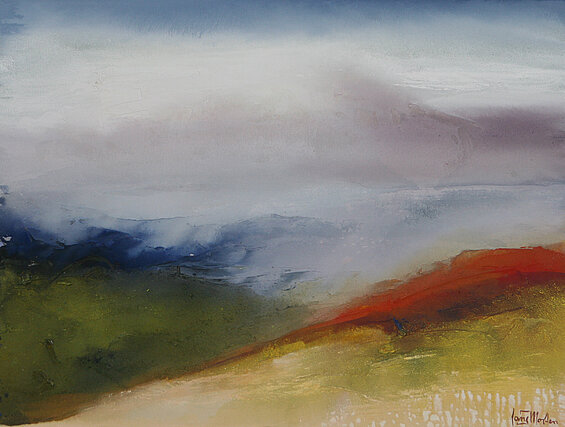BETWEEN TIME AND ETERNITY
By C.F. Garde, writer and artcritic
In a way it is a paradoxical title that Jane Morten has gathered the pictures under: "While there is time ". I suppose it means that we are here now, the time is short and we have to live while we are alive. She has said of her painting that it is about mutability and transience, a memento of what always disappears: ' the light. the longings, the dreams, and time.
But at the same time her painting can be experienced as a negation of time, The sun rises and sets, the seasons change, nature rages or rests. This is the life her pictures show. Not bombed cities, slum areas or motorways through landscapes, but the nature that in the end is stronger than mankind, For me Jane Morten's pictures are instants of eternity, they are about something that always is, independently of civilization's epochs, mankind's man-made conditions on Earth.
"My pictures should not be understood verbally," she has said. "I want to communicate a sensual, beautiful and moving experience which makes one feel life as a presence."
She succeeds in that, Imagine, an artist who, at the fag-end of a worn-out century, dares to admit a quest for beauty! A rootless century which through two world wars, decade by decade, has renounced known values - both in art and life - in the hope of finding truth in the latest gimmick.
She paints landscapes, but not places that can be found on a map. She moves in regions never seen, but still recognized: archetypal imprints on the mind, forgotten or repressed unt il one stands amidst them overwhelmed by familiarity. Present. Not a human being in sight. and yet the pictures breathe with a sense of home, This is where we come from , What we were driven out of?
That is the enchantment. Places that do not exist, but which materialize before your eyes, Dreams so delicate that it takes the mind of a painter like Jane Morten to capture them and make them real. Reeds, grass, sky, reflections, light
and dark, The sun as a fire or a dawn just light enough so things can be glimpsed. Ditch or jungle - you cannot say, and it isn 't really important.
As an artist she both belongs to her time and stands outside it. She paints nature but she is not a naturalist. She paints in many layers and goes exploring in them by scratching with the wrong end of the brush or scraping with a spatula so a wilderness emerges. She travels in unknown country, but towards a goal she has glimpsed from the beginning. Technique, yes, but first and foremost a process that creates depth and space and matches the content closely.
In some works scratches and scrapes become independent elements; in others, like plants, they underscore the shape of the landscape, become so to speak the mesh through which her reality is sieved. Without the scratching these pictures would probably stand as abstract totalities. The colours vary from work to work in fine balances, even though the whole palette is exploited. She has a wonderful knack of making foreground colours recede into the background and drawing out background colours so that strange perspectives of pure poetry arise. At one time, perhaps after she had been travelling, mountains appeared at the edge of the field of vision in the pictures, as massive allusions to the reality out of which her dreams grow.
Recently she has painted pictures without these foreground growths: clearer, as if she has cut through the wilderness and sees the world lying open in front of her. She wants to paint that which has perished, yet captures what remains. This is the paradox - the ostensible self-contrad iction, She creates between dream and reality on her very own terms, A rare phenomenon in modern painting.


